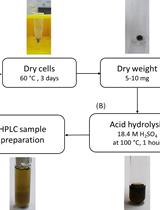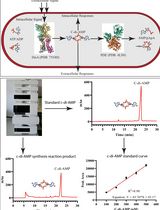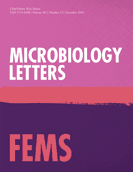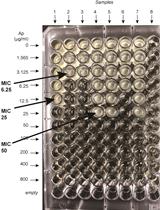- EN - English
- CN - 中文
Determination of Polyhydroxybutyrate (PHB) Content in Ralstonia eutropha Using Gas Chromatography and Nile Red Staining
采用气相色谱法和尼罗红染色法测定富养罗尔斯通菌中聚羟基丁酸酯(PHB)的含量
(*contributed equally to this work) 发布: 2018年03月05日第8卷第5期 DOI: 10.21769/BioProtoc.2748 浏览次数: 17940
评审: Dennis NürnbergBenoit ChassaingAnonymous reviewer(s)

相关实验方案

酸水解-高效液相色谱法测定集胞藻PCC 6803中聚3-羟基丁酸酯的含量
Janine Kaewbai-ngam [...] Tanakarn Monshupanee
2023年08月20日 1777 阅读

基于高效液相色谱法的史氏分枝杆菌DisA环二腺苷酸(C-di-AMP)合成酶活性研究
Avisek Mahapa [...] Dipankar Chatterji
2024年12月20日 1750 阅读
Abstract
Ralstonia eutropha H16 produces and mobilizes (re-utilizes) intracellular polyhydroxybutyrate (PHB) granules during growth. This protocol describes the visualization of intracellular Nile red stained PHB granules and the quantification of PHB by gas chromatography. Our first method describes how to analyze PHB granules by fluorescence microscopy qualitatively. Our second approach enables the conversion of PHB to volatile hydroxycarboxylic acid methyl esters by acidic methanolysis and their quantification by gas chromatography. Through this method, it is possible to obtain an absolute quantification of PHB, e.g., per cell dry weight.
Keywords: Polyhydroxybutyrate (PHB) (聚羟基丁酸酯(PHB))Background
Polyhydroxyalkanoates (PHA), especially polyhydroxybutyrate (PHB), are energy and carbon storage compounds in many prokaryotic species, ensuring bacterial survival under stress conditions (Anderson and Dawes, 1990; Pötter and Steinbüchel, 2006; Jendrossek and Pfeiffer, 2014; Bresan et al., 2016). An industrial application of these biopolymers is the production of biodegradable plastic (Chen, 2009; Riedel et al., 2015) and the research on potential medicinal components (Wu, 2009; Zonari et al., 2015; Pacheco et al., 2015; Giretova et al., 2016). Ralstonia eutropha H16, a Gram-negative facultative chemolithoautotrophic β-proteobacterium, is a model organism for PHB accumulation as it can accumulate up to 80% of its cell dry weight of PHB. Within the cells, PHB forms granules or so-called carbonosomes covered with different surface proteins (Jendrossek and Pfeiffer, 2014; Bresan et al., 2016). PHB is synthesized from its parent substance acetyl-CoA in a 3-step reaction. The first step is a condensation reaction of two acetyl-CoA molecules by the acetyl-CoA-acetyltransferase PhaA. Acetoacetyl-CoA is then reduced to (R)-3-hydroxybutyryl-CoA by the acetoacetyl-CoA-reductase PhaB. The last step includes an essential non-redundant reaction: the polymerization of (R)-3-hydroxybutyryl-CoA to PHB by the PHB synthase called PhaC (Figure 1).
Figure 1. Biosynthesis of PHB
A fast and easy way to detect intracellular PHB is a microscopy approach using Nile red staining. Nile red (also known as Nile blue oxazone) is a lipophilic fluorescent dye used to visualize hydrophobic cell structures such as membranes or lipid-like inclusions (PHB, triacyl-glycerides) (Spiekermann et al., 1999). Nile red binds to PHB granules and can easily be detected by fluorescence microscopy. Its colors (i.e., fluorescent emission wave lengths) vary from dark red (for binding to polar membrane lipids) to an intense yellow-gold emission (for binding to neutral lipids in intracellular storages). The emission (> 590 nm) and excitation (560 nm) wavelengths characteristic of the Nile red hydrophobic compound adducts also depend on solvent polarity (Spiekermann et al., 1999); in most polar solvents Nile red shows no or only little fluorescence.
Gas chromatography (GC) can be used to quantify PHB and to determine its monomeric composition. PHB decomposes at temperatures below its boiling point. Therefore, PHB must be converted into products that are stable and volatile at the temperature of the GC-column. This is achieved by conversion of PHB into volatile hydroxycarboxylic acid methyl esters, hereafter, methyl esters (Figure 2) (Brandl et al., 1988). The methyl esters interact specifically with the solid phase thereby allowing a separation of different hydroxyalkanoate methyl esters in case co-polyesters of different hydroxyalkanoates have to be analyzed. Measuring the time point of appearance and the area under the resulting compound peak of the detector signals in the chromatogram enable its quantitative and qualitative determination.
Figure 2. Acidic methanolysis of PHA
Materials and Reagents
- Microscope slides (e.g., Carl Roth, catalog number: H868.1 )
- Cover slips (e.g., Carl Roth, catalog number: H873.2 )
- 2 ml reaction tubes (e.g., SARSTEDT, catalog number: 72.695.500 )
- 50 ml Falcon tubes (e.g., SARSTEDT, catalog number: 62.559.001 )
- 6 ml culture tubes with screw-cap with chloroform resistant PTFE seal (e.g., DWK Life Sciences, DURAN, catalog number: 26 135 11 5 )
- GC glass vial (e.g., Brown, catalog number: 155710 )
- 50 ml Omnifix® Syringes (e.g., B.Braun Medical, catalog number: 4591281 )
- Sterile filter Filtropur S 0.2 (e.g., SARSTEDT, catalog number: 83.1826.001 )
- Scalpel blade (e.g., Gebrüder Martin, KLS Martin, catalog number: 10-155-24-04 )
- Pipette tips 1,000 μl (e.g., SARSTEDT, catalog number: 70.762.010 )
- Pipette tips 200 μl (e.g., SARSTEDT, catalog number: 70.760.002 )
- Pipette tips 10 μl (e.g., VWR, catalog number: 53509-070 )
- 1.5 ml tubes (e.g., SARSTEDT, catalog number: 72.690.001 )
- 0.3 ml limited volume inserts (e.g., Brown, catalog number: 155650 )
- Septa (e.g., Brown, catalog number: 155615 )
- Organisms
- Ralstonia eutropha H16 (alternative strain designations: Hydrogenomonas eutropha H16, Alcaligenes eutrophus H16, Wautersia eutropha H16, Cupriavidus necator H16). DSM 428 (Deutsche Sammlung für Mikroorganismen and Zellkulturen GmbH, https://www.dsmz.de/). Wild type strain produces PHB and related short-chain-length PHA
- Ralstonia eutropha H16-PHB-4 (DSM 541), PHB negative mutant of strain H16 because of mutation G320A in the PHB synthase (phaC) gene (Raberg et al., 2014)
- Ralstonia eutropha H16 (alternative strain designations: Hydrogenomonas eutropha H16, Alcaligenes eutrophus H16, Wautersia eutropha H16, Cupriavidus necator H16). DSM 428 (Deutsche Sammlung für Mikroorganismen and Zellkulturen GmbH, https://www.dsmz.de/). Wild type strain produces PHB and related short-chain-length PHA
- PHB (e.g., Sigma-Aldrich, catalog number: 363502 )
- Agarose standard (e.g., Carl Roth, catalog number: 3810.4 )
- Nitrogen gas (e.g., Air Liquide, ALPHAGAZTM 1 Stickstoff, catalog number: P0271L50R2A001 )
- Helium gas (e.g., Air Liquide, ALPHAGAZTM 1 Helium, AIR LIQUIDE Deutschland, catalog number: P0251L50R2A001 )
- Synthetic air (e.g., Air Liquide, ALPHAGAZTM 1 Luft, AIR LIQUIDE Deutschland, catalog number: P0291L50R2A001 )
- Octane (e.g., Sigma-Aldrich, catalog number: 74821 )
- Nile red (e.g., Sigma-Aldrich, catalog number: N3013 )
- DMSO (e.g., Carl-Roth, catalog number: 7029.2 )
- Trichloromethane/Chloroform (e.g., Carl Roth, catalog number: 6340.2 )
- Methanol for GC (e.g., VWR, catalog number: 20864.320 )
- Methyl benzoate (e.g., Sigma-Aldrich, catalog number: M29908 )
- Sulphuric acid 96% (e.g., Carl Roth, catalog number: 4623.1 )
- Fructose
- Nutrient broth (e.g., BD, DifcoTM, catalog number: 231000 )
- Na2HPO4·12H2O
- KH2PO4
- NH4Cl
- MgSO4·7H2O
- CaCl2·7H2O
- Ferric ammonium citrate
- ZnSO4
- MnCl2·4H2O
- H3BO3
- CoCl2·6H2O
- CuCl2·2H2O
- NiCl2·6H2O
- NaMoO4·2H2O
- D-Gluconic acid sodium salt (e.g., Sigma-Aldrich, catalog number: G9005 )
- NB medium (see Recipes)
- Mineral salts medium (see Recipes)
- D-Gluconic acid sodium salt solution (20% stock solution) (see Recipes)
- Nile red solution (see Recipes)
Equipment
- 100 ml Erlenmeyer flasks (e.g., DWK Life Sciences, DURAN, catalog number: 21 216 24 )
- 500 ml Erlenmeyer flasks (e.g., DWK Life Sciences, DURAN, catalog number: 21 216 44 )
- 3 L Erlenmeyer flasks (e.g., DWK Life Sciences, DURAN, catalog number: 21 216 68 )
- Incubation shaker (e.g., INFORS HT)
- Pipettes (e.g., Thermo Scientific)
- Spatula
- Centrifuge (e.g., Eppendorf, model: 5417 C )
- Freeze-dryer (e.g., Christ, model: Alpha 1-2 LDplus )
- Rotary vane pumps (e.g., Pfeiffer Vacuum, model: DUO 5 M )
- Analytical balance (e.g., Sartorius, model: A 200 S )
- Fume hood
- Oil bath (e.g., Memmert)
- Gas chromatograph (e.g., Agilent Technologies, model: Agilent 7890A ; flame ionization detector (FID))
- Gastight syringe for GC (e.g., VWR, catalog number: 5490572)
Manufacturer: Hamilton, model: 1701 SN CTC . - CTC automated sample injector (e.g., Agilent Technologies, catalog number: G6501-CTC )
- GC column DB-WAX (e.g., Agilent Technologies, catalog number: 122-7032 )
- Fluorescence microscope with a Plan Apo objective (100x/1.4 oil) (e.g., Nikon Instruments, model: Eclipse Ti-E )
- Nile red-Filter (Excitation: 562/40 nm/Emission: 594 (long pass), e.g., AHF Analysentechnik AG, Tübingen, Germany, www.ahf.de/)
- Liner 4 mm ID LPD (e.g., Agilent Technologies, catalog number: 5183-4647 )
- Freezer
- Sterile bench (e.g., HERA safe)
- Refrigerated Falcon centrifuge (e.g., Sigma Zentrifugen, model: 4K15 )
- Vortex
- Laboratory glass bottles (e.g., DWK Life Sciences, DURAN, catalog number: 21 801 54 5 )
- Autoclave
Software
- GC ChemStation Rev. B.04.01 SP1, Agilent
- Excel, Microsoft, Redmont, USA
- Nikon imaging software
- ImageJ Fiji vl.50c
Procedure
文章信息
版权信息
© 2018 The Authors; exclusive licensee Bio-protocol LLC.
如何引用
Juengert, J. R., Bresan, S. and Jendrossek, D. (2018). Determination of Polyhydroxybutyrate (PHB) Content in Ralstonia eutropha Using Gas Chromatography and Nile Red Staining. Bio-protocol 8(5): e2748. DOI: 10.21769/BioProtoc.2748.
分类
微生物学 > 微生物生物化学 > 其它化合物
生物化学 > 其它化合物 > 聚-β-羟基丁酸
您对这篇实验方法有问题吗?
在此处发布您的问题,我们将邀请本文作者来回答。同时,我们会将您的问题发布到Bio-protocol Exchange,以便寻求社区成员的帮助。
Share
Bluesky
X
Copy link









